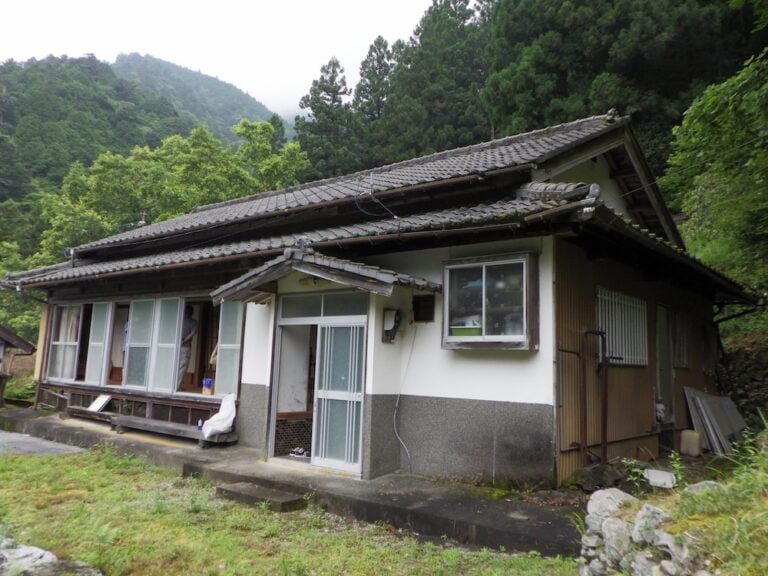
Picture Japan in your mind for a moment.
You might think about Tokyo’s bustling urban streets, with crowded trains and vibrant lights everywhere you go. Or perhaps the lively markets of Kyoto, featuring stalls with an array of seafood and mochi.
Maybe you picture narrow wooden alleys where women in kimonos stroll, a delicate paper umbrella on their shoulders. Or the numerous temples and shrines, with painted torii gates leading to lush gardens in the historical sites of Japan.

But there’s more to Japan than these picturesque scenes often shared on social media by happy tourists. While these views do capture the charm of Japan, they represent just one facet of its complex society.
Beyond the clean and beautiful city facades, you’ll find that the countryside has a vastly different scene. As you drive into rural Japan, past rice paddies and tea fields, you discover many buildings covered in vegetation, slowly succumbing to the passage of time. These are remnants of a bygone era; homes once vibrant with families and locals are now abandoned and fading into the landscape and wildlife of Japan.
Meet the “akiya.”
What is an Akiya?
So, what exactly is an “akiya”?
The term “akiya” in Japanese literally translates to “empty house,” referring to the abandoned homes and, in more severe cases, the decline of rural communities.
Legally, a property undergoes a thorough evaluation to be declared with akiya status with factors such as the flow of people throughout the year and the usage of water, electricity, and gas taken into consideration. When a property is found to be uninhabited, it’ll be declared akiya.
According to the latest survey by the Ministry of Internal Affairs in Japan, approximately 1 in 8 houses is classified as an akiya. This ratio increases to 1 in 5 in certain prefectures, totaling around 8.5 million properties across the country.
Akiya can be categorized into four types: those for rent, those for sale, second houses, and “others.” Over time, the number of properties available for sale or rent has decreased, while the count of akiya falling into the “other” category — those left truly abandoned — has seen an increase.

How are Ghost Towns created?
In the coming year, it’s expected that Japan will have around 11 million empty homes. By 2038, as some predictions suggest, nearly one-third of Japan’s homes could be vacant.
A study from the National Institute of Population and Social Security Research highlights that almost 60% of Japan’s folks live in cities, with Tokyo alone making up over 13% of the total population. The trend of young folks moving to cities for job opportunities has left many countryside areas with mostly older residents, leading to an overall population decrease.
The shrinkage of traditional industries like farming and fishing has also played a role in these areas losing people. Reports show that Japan’s farming sector has been declining for years. This decline is caused by various reasons, like pressures to work in salary positions with university degrees and increase in use of machines and automation in agriculture.
Another significant factor contributing to this issue stems from demographics. The aging and diminishing population, with only a small counterbalance from immigration, creates a fundamental strain leading to an excess of housing.
Decades of housing policy have exacerbated this situation by neglecting population decline, failing to address unwanted or unusable properties, and encouraging construction merely to boost the gross domestic product.

An interesting point in NRI’s forecast, which considers unoccupied second homes and properties available for rent or sale, is the expectation that, despite the number of empty units doubling between 2023 and 2038, over 8 million new constructions will be added.
Data from the National Institute of Population and Social Security Research suggests that from 2023 onward, justifying this trend should become increasingly challenging. Even though Japan’s population has been shrinking for more than a decade, the impact on housing surplus has been temporarily mitigated by the continuous increase in the total number of households (attributed to more people living alone and increased longevity), reaching its peak next year at 54.19 million.
Following this peak, the housing surplus is anticipated to escalate more significantly, putting additional downward pressure on property prices.
The outcome of these situations is the formation of ghost towns and deserted villages. These places often have a sad and spooky feel, attracting photographers and explorers. These abandoned spots have even become tourist attractions, drawing people who want to see the empty homes and buildings.
What are the incentives for these abandoned places?
In an effort to address the decline in rural populations and prevent the emergence of ghost towns, the Japanese government has undertaken initiatives to encourage city dwellers to relocate to the countryside.
Financial Incentives for Families
To combat the rapid population, decline in rural areas, the government has introduced a bold move—offering families 1 million yen per child to leave the bustling Greater Tokyo Area in the fiscal year 2023. However, this offer comes with conditions. Families must commit to spending at least five years in the new location, and one family member must have a stable job, either working remotely from their new home, finding employment at local small and medium-sized enterprises, or having plans to start a new business in the area.
The child should be under 18, but they can be older if they are still enrolled in school. If the family relocates before completing the five-year commitment, they are required to return the money to the government.
Incentives for Akiya Buyers
In a separate initiative, the government offers people in urban areas a lump sum of $500 and tax breaks to encourage them to move to rural areas. However, this strategy has seen limited success in addressing the akiya (empty houses) issue. Many are skeptical about the deal’s overall value, considering that, after purchasing a house with the provided money, additional thousands must be spent on renovating abandoned homes to make them habitable.
The challenge lies in convincing people that the financial incentives outweigh the potential sacrifices regarding quality of life and convenience associated with urban living. The government is actively working to showcase the advantages of rural living in an ongoing effort to persuade citizens that the move is worthwhile.

Where can I find an Akiya?
If you’re dreaming of a quieter life in the countryside, working online, or just have some extra cash to invest, you might be interested in buying one of those abandoned homes. But how do you find one?
Efforts to address this issue are happening at the regional and municipal levels. Enter the so-called “akiya-banks,” established to connect these vacant homes with new owners. While some are accessible for online consultations, many towns and municipalities maintain their own listings of local akiya. Keep in mind that the options and quality of information can vary between websites and providers.
Akiya banks, regardless of the provider, go beyond just acting as intermediaries. They play a role in revitalizing rural areas by providing economic aid to those looking to purchase akiya. Unlike traditional real estate agencies, akiya banks also facilitate property sales through auctions, often offering favorable prices.
Given the affordable nature of akiya and the growing trend of remote work and flexible lifestyles, both Japanese residents and foreigners are increasingly considering buying and renovating these abandoned homes. While renovating semi-abandoned houses can be costly, there’s good news. National and local governments offer subsidies and tax deductions to assist with the renovation process, covering aspects such as seismic retrofitting and energy-saving improvements.
Despite these efforts, the prevalence of akiya is likely to persist unless there’s a reversal in the current demographic trend.















